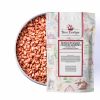





Using Umeboshi Flavored Sesame Seeds in Cooking
Sesame seeds are a staple in Asian cuisine, especially in Japanese cooking. Flavored with umeboshi plum, a fruit from the Japanese apricot tree, these sesame seeds are both subtle and full of flavor, adding a touch of originality to your dishes.
How to Use Umeboshi Flavored Sesame Seeds in Cooking?
Here are some recipe ideas to incorporate umeboshi flavored sesame seeds into your cooking:
- Umeboshi Onigiri: sprinkle umeboshi flavored sesame seeds over your rice before adding your ingredients and rolling it up;
- Japanese Dressing: in your vinaigrette made with rice vinegar, chopped fresh ginger, and yuzu juice, add 1 teaspoon of umeboshi flavored sesame seeds;
- Tomato and Umeboshi Tart: place tomato slices on your pre-baked puff pastry and sprinkle 1 teaspoon of umeboshi flavored sesame seeds before baking;
- Spring Rolls: add 1 teaspoon of umeboshi flavored sesame seeds to your spring rolls before rolling them up;
- Japanese Cucumber Salad: slice your cucumber and sprinkle 1 tablespoon of umeboshi flavored sesame seeds, then pour your dressing.
Aromas of Umeboshi Flavored Sesame Seeds
Umeboshi flavored sesame seeds reveal tangy and salty flavors. In the mouth, they leave a gentle taste of toasted seeds that is very flavorful.
The Botany of Sesame Seeds
Sesame, or Sesamum indicum, is a plant in the Pedaliaceae family. This plant is widely cultivated in regions such as Africa and Asia for its seeds. Whether used raw, toasted, or ground, sesame seeds are very present in European, Asian, and American cuisine.
Discovering Umeboshi Plum
Umeboshi plum comes from a tree related to those of the apricot and plum family. The fruit of this tree is a Japanese plum called "ume". This plum is not consumed raw but only cooked, in the form of jam, candy, or syrup. It is also used to make umeshu, a very fruity and sweet Japanese liqueur.
It is also pickled in brine or dried.
Sesame Seeds in History
Sesame seeds originated in the East Indies. 3,000 years before Christ, the Chinese used sesame seeds as ink by transforming them into oil and then burning this oil to produce a black color. Over time, sesame seeds have traveled the world to finally be used in kitchens in the form of oil, pastes, plain or flavored seeds.
| Allergen | Sésame, Poisson / Sesame , Fish |
|---|---|
| Native country | JAPON |
| Genus and botanical species | Sesamum indicum |
| Ingredients | roasted SESAME 84.9%, salt, sugar, fermented condiment, FISH sauce, |
| plum pulp 0.38%, flavor enhancer (E621), acidulant (E330), coloring | |
| agent (E163), flavor enhancer (E635), shiso flavor. | |
| Nutritional Info | VN Energie pour 100 g (energy for 100g) : 2439 kJ / 583 kcal VN Matière grasse (fat) : 49.2 g Dont acide gras saturés (of which saturated fat) : 7.65 g VN Glucides (carbohydrate) : 21 g Dont sucres (of which sugars) : 2.7 g VN Protéines (protein) : 18.6 g Vn Sel (salt) : 6.2 g |
| TRACES EVENTUELLES D'ALLERGÈNES | céleri, sésame, moutarde, fruits à coques. |
 Français
Français 